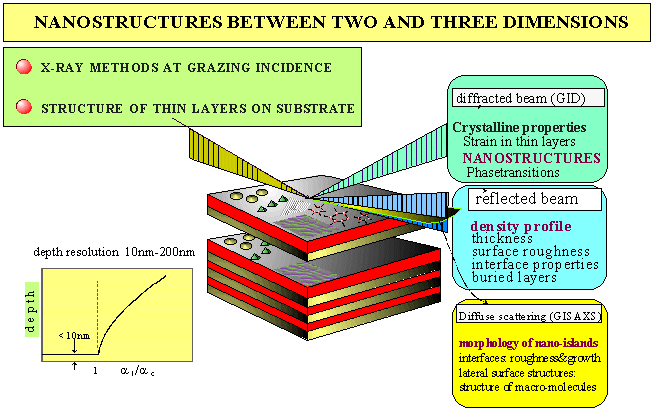- Home
- Users & Science
- Find a beamline
- X-ray nanoprobe
- ID01 - Nano/Micro diffraction imaging
- Other Scientific Applications and Projects
- Scattering at Grazing Incidence (GISAXS and GID)
Scattering at Grazing Incidence (GISAXS and GID)
Due to the versatility of the diffractometer, the high brilliance and the highly parallel beam SAXS and WAXS experiments can be performed at grazing incidence and grazing exit. Here refraction effects are exploited to change the penetration depth of the x-rays and an evanescent wave is "implanted" close to the sample surface, thus allowing for depth-resolved measurements in a typical range between 10 and 200 nm. For high resolution work the GI geometry can be combined with triple crystal diffractometry by use of the analyser stage. In addition, the diffractometer allows to switch from grazing incidence to large angle geometry without the necessity to remount the sample. Thus, lateral and vertical structural properties can be probed simultaneously. All scans may be run in HKL mode (reciprocal space mapping). These methods may be combined with the advantages of anomalous scattering.
Examples to study are (see also schematic figure below):
- Surface and interface roughness of single and multilayered structures
- Morphology and crystalline structure of thin films on substrates
- Semiconductor nanostructures, quantum dots and quantum wires (grown self-organised or fabricated by lithography and etching)
- Shape, strain, ordering and correlation of small crystalline islands on substrates
- Structure of Phospholipid layers
- phase transition in thin layers or close to surfaces
- phase transition and structures in confined environment (nano-tubes, zeolites, nanostructured metallic alloys etc)
- magnetic nanostructures
- thin wave guide structures
- defects close to surfaces and in thin layers (diffuse scattering at GI, reciprocal space mapping)




